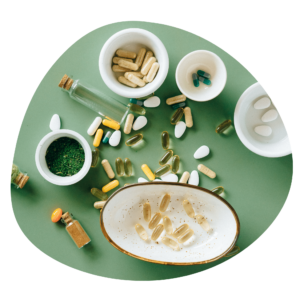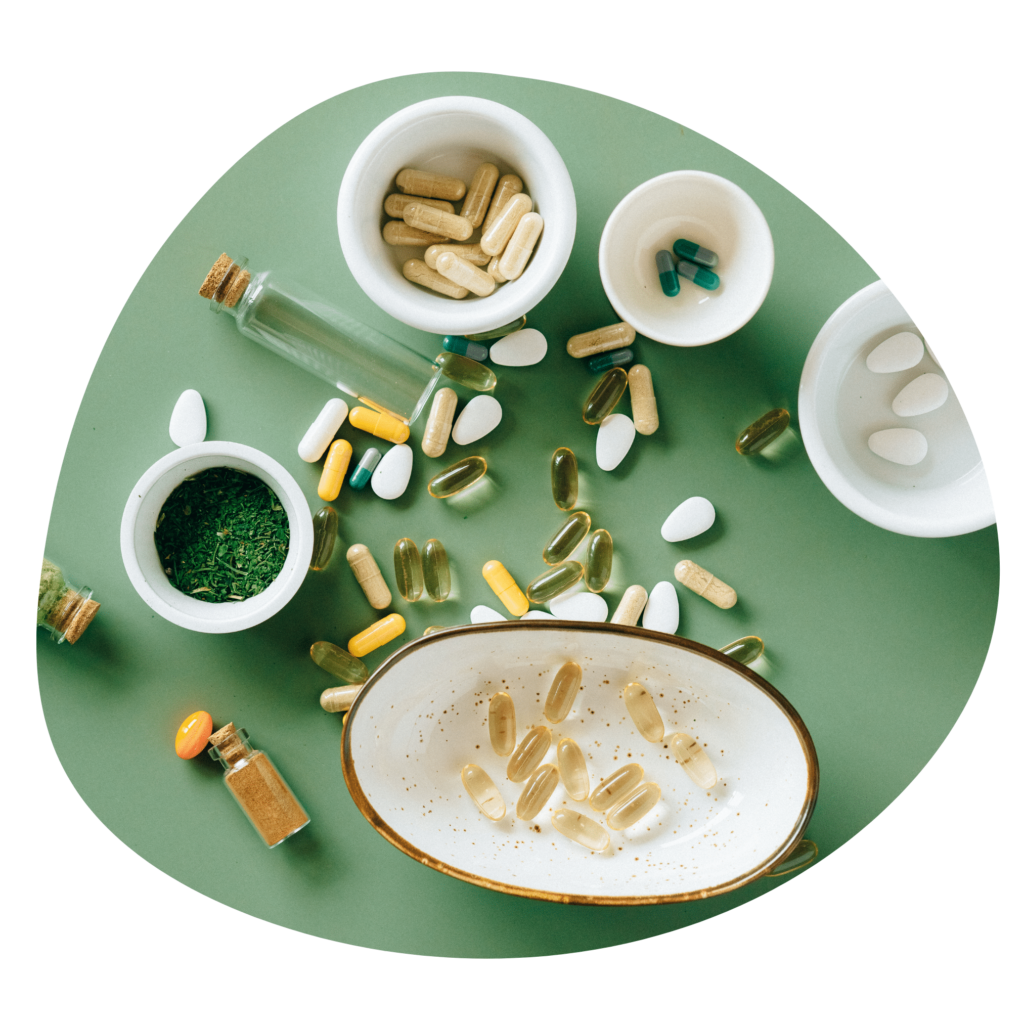Hypermobility & Low Dose Naltrexone : Treatments within functional medicine.

Last week we took a deep dive into symptoms of hypermobility syndrome and what receiving a diagnosis might mean. In this post, we will explore how a functional medicine practitioner may treat this condition, including the medication Low Dose Naltrexone.
As a reminder – if you’ve got joints that seem to move beyond their normal range and you’re dealing with the pain and risk of injuries that come with it, you might be familiar with hypermobility syndrome!
While traditional treatments often focus on physical therapy and pain management, there’s a growing interest in MORE holistic approaches to tackle this condition. So, let’s dive into how a functional provider might help you manage hypermobility syndrome with lifestyle changes, dietary tweaks, supplements, and more.
Lifestyle and Dietary Recommendations
Anti-inflammatory Diet A big part of managing hypermobility syndrome is reducing inflammation. This means shifting towards whole, unprocessed foods. Think vibrant veggies, lean proteins, and healthy fats. Omega-3 fatty acids, found in fish oil and flaxseeds, are fantastic for fighting inflammation. And let’s not forget to cut down on refined sugars, processed foods, and trans fats – they’re notorious for ramping up inflammation. Some seemingly healthy foods can be more inflammatory than others depending on the individual be it corn, nightshades, peanut, gluten, etc. Dr. McCubbins can guide you through finding those triggers.
Adequate Hydration Staying hydrated is crucial for keeping your joints lubricated and functioning smoothly. Make sure you’re drinking enough water throughout the day.
Nutritional Supplements & Herbs
Collagen and Gelatin These supplements could do wonders for your joints and connective tissues. They provide the building blocks your body needs to support joint health as well as hair, skin and nail integrity.
Glucosamine and Chondroitin These are well-known for their ability to support joint structure and function. They might be worth considering if you’re looking to give your joints some extra love.
Magnesium Magnesium is great for muscle function and can help reduce cramps and spasms. It’s a key electrolyte for muscle function (including the heart), mitochondrial health and hydration.
Anti-inflammatory Plant Medicine Nature offers some powerful anti-inflammatory herbs. Turmeric, ginger, bromelain, quercetin, and boswellia are among the best. They can help reduce inflammation and ease pain naturally.
Adaptogenic Herbs Ashwagandha and rhodiola are fantastic for helping your body manage stress, which can be a big part of dealing with chronic pain.
Physical and Manual Therapies
Gentle Strengthening Exercises Exercises aimed at stabilizing the joints without causing strain are key. Pilates, especially when tailored for hypermobility syndrome, can be incredibly beneficial. Do not overstretch. Hiking and walking are ideal routine approaches to exercise!
Massage Therapy Regular massages can help relieve muscle tension, fascia, and improve circulation, making you feel more relaxed and less achy.
Chiropractic Care or Osteopathy Gentle manipulations from a skilled practitioner can help maintain joint alignment and overall function.
Physical therapy: If in need of PT, it is important to work with a skilled, hypermobility syndrome specialist. Counterstrain approaches are considered standard of care.
Mind-Body Approaches
Stress Management Stress can exacerbate pain, so techniques like mindfulness, meditation, and deep breathing exercises are crucial. They can help you manage both stress and pain effectively.
Cognitive Behavioral Therapy (CBT) CBT is a powerful tool for managing chronic pain. It helps you develop coping strategies and change the way you perceive and respond to pain.

Low Dose Naltrexone, or ‘LDN’ for treating Hypermobility
Originally, naltrexone is used “on label” in higher doses (50mg) to treat opioid and alcohol dependence. But in much smaller doses, typically 1.5 to 4.5 mg per day, it has been making waves in the medical community for its incredible potential as an adjunct treatment to a variety of conditions. The magic lies in its ability to modulate the immune system and reduce inflammation. It also has a gentle and supportive effect on the autonomic nervous system.
Why Consider Low Dose Naltrexone for Hypermobility Syndrome?
Hypermobility syndrome often comes with chronic pain, inflammation, and sometimes even autoimmune conditions. Here’s where LDN might be your new best friend:
- Chronic Pain Relief: Dealing with constant joint pain? LDN might help. By temporarily blocking opioid receptors, LDN encourages your body to produce more endorphins and enkephalins—your natural painkillers. More endorphins can mean less pain. It is NOT a narcotic or opioid medication itself.
- Inflammation Buster: If inflammation is adding to your woes, LDN’s action on the body’s inflammasome could be beneficial. By modulating the immune system, it can help keep inflammation in check, potentially easing those achy joints.
- Supporting Autoimmune Conditions: Hypermobility syndrome is sometimes linked with autoimmune disorders. LDN’s ability to regulate the immune system can be particularly helpful here, offering a two-fold benefit by addressing both hypermobility syndrome and associated autoimmune issues.
Is Low Dose Naltrexone Right for You?
LDN isn’t a standard treatment for hypermobility syndrome, and it’s typically prescribed off-label at a compounding pharmacy for this purpose. However, it could be a valuable part of your treatment plan, especially if you’re dealing with chronic pain or inflammation. Here are a few things to keep in mind:
- Prescription: You’ll need a healthcare provider who’s familiar with LDN and understands your specific health needs. Vytal Health can help get you established with one!
- Dosage: LDN is taken in much smaller doses than regular naltrexone—usually between 1.5 to 4.5 mg daily.
- Monitoring: Regular check-ins with your healthcare provider are crucial to ensure it’s working effectively and to manage any side effects.
Customized Treatment Plan
A functional approach is all about you – your body, your lifestyle, and your specific needs. During your appointment with a Vytal Health provider, expect a thorough assessment, including a detailed medical history, nutritional analysis, and lifestyle evaluation. This helps create a personalized treatment plan tailored just for you that!
Regular Monitoring and Adjustment
Your treatment plan isn’t set in stone. It’s regularly reviewed and adjusted based on your progress and any new symptoms or issues that arise. This ensures that you’re always getting the best possible care.
By embracing these treatments, you can enhance your overall well-being, support your joint health, and promote a balanced and healthy lifestyle. If you’re ready to explore a holistic approach to managing hypermobility syndrome, Dr McCubbins might be your perfect partner on this journey.
The Bottom Line when considering Low Dose Naltrexone for Hypermobility
Living with hypermobility syndrome can be challenging, but you don’t have to navigate it alone. Exploring options like LDN, vitamins, herbs, and other suggestions in this post, might just give you the relief you’ve been searching for. Here’s to finding more comfortable and flexible days ahead!
Feel free to reach out to our team if you have any questions or want to learn more about integrating LDN into your hypermobility syndrome treatment plan. We’re here to help you explore all your options on your journey to better health!
